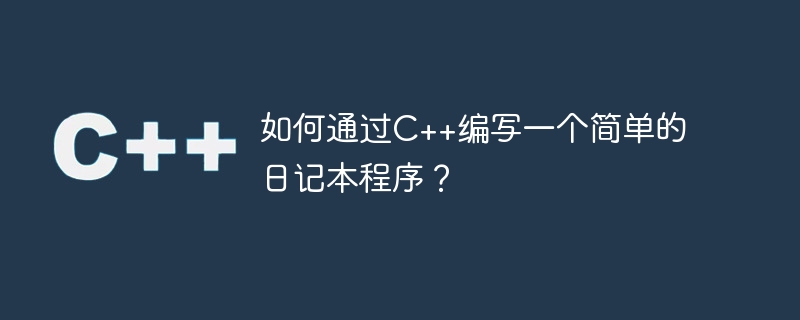

How to write a simple diary program in C?
Diaries are a tool for many people to record their lives, thoughts and feelings. By writing a simple diary program, you can record and manage personal diaries more conveniently and efficiently. In this article, we will introduce how to write a simple diary program using C language.
First of all, we need to determine the basic functions of the diary program. A simple diary program should have the following functions:
Next, we can start writing this diary program. First, you need to create a diary class to represent each diary. This class should contain the following properties: date, title, and content. We can use C structure to implement this diary class.
struct Diary {
std::string date;
std::string title;
std::string content;
};Then, we can create a diary class to manage the functions of adding, viewing, editing and deleting diaries. This class should contain the following member functions: add diary, view diary, edit diary and delete diary.
class DiaryBook {
public:
void addDiary();
void viewDiary();
void editDiary();
void deleteDiary();
private:
std::vector<Diary> diaries;
};Now, we can implement the member functions of the diary class. The first is the function addDiary() to add a diary. This function should first let the user enter a date, title, and content, save this information into a new journal object, and then add the new journal object to the journal's journal list.
void DiaryBook::addDiary() {
Diary newDiary;
std::cout << "请输入日期:";
std::cin >> newDiary.date;
std::cout << "请输入标题:";
std::cin >> newDiary.title;
std::cout << "请输入内容:";
std::cin >> newDiary.content;
diaries.push_back(newDiary);
}Next is the function viewDiary() to view the diary. This function should first list the titles of all the diaries that have been saved in the diary and let the user choose to view one of them. Then, according to the user's selection, the date, title and content of the diary are output.
void DiaryBook::viewDiary() {
if (diaries.empty()) {
std::cout << "日记本为空!" << std::endl;
return;
}
std::cout << "请选择要查看的日记:" << std::endl;
for (int i = 0; i < diaries.size(); i++) {
std::cout << i + 1 << ". " << diaries[i].title << std::endl;
}
int choice;
std::cin >> choice;
if (choice >= 1 && choice <= diaries.size()) {
const Diary& selectedDiary = diaries[choice - 1];
std::cout << "日期:" << selectedDiary.date << std::endl;
std::cout << "标题:" << selectedDiary.title << std::endl;
std::cout << "内容:" << selectedDiary.content << std::endl;
} else {
std::cout << "选择无效!" << std::endl;
}
}The implementation logic of the rest of the editing diary function editDiary() and the deletion diary function deleteDiary() is similar and will not be shown in detail here.
Finally, create a DiaryBook object in the main function and use a loop menu to allow the user to choose to perform different operations.
int main() {
DiaryBook diaryBook;
while (true) {
std::cout << "请选择操作:" << std::endl;
std::cout << "1. 添加日记" << std::endl;
std::cout << "2. 查看日记" << std::endl;
std::cout << "3. 编辑日记" << std::endl;
std::cout << "4. 删除日记" << std::endl;
std::cout << "0. 退出" << std::endl;
int choice;
std::cin >> choice;
switch (choice) {
case 1:
diaryBook.addDiary();
break;
case 2:
diaryBook.viewDiary();
break;
case 3:
diaryBook.editDiary();
break;
case 4:
diaryBook.deleteDiary();
break;
case 0:
return 0;
default:
std::cout << "选择无效!" << std::endl;
break;
}
}
return 0;
}Through the above implementation, we have completed a simple diary program. Users can add, view, edit and delete journals by selecting different actions. Of course, this is just a simple example, you can expand and optimize the program according to actual needs.
To sum up, writing a simple diary program in C is very interesting and practical. Whether it is used as a hands-on project for learning C or as a practical tool, it can help us record and manage our life diaries more conveniently.
The above is the detailed content of How to write a simple diary program in C++?. For more information, please follow other related articles on the PHP Chinese website!
 What are the differences between c++ and c language
What are the differences between c++ and c language
 Recommended learning order for c++ and python
Recommended learning order for c++ and python
 Cost-effectiveness analysis of learning python and c++
Cost-effectiveness analysis of learning python and c++
 Is c language the same as c++?
Is c language the same as c++?
 Which is better to learn first, c language or c++?
Which is better to learn first, c language or c++?
 The difference and connection between c language and c++
The difference and connection between c language and c++
 C++ software Chinese change tutorial
C++ software Chinese change tutorial
 Cost-effectiveness analysis of learning python, java and c++
Cost-effectiveness analysis of learning python, java and c++




